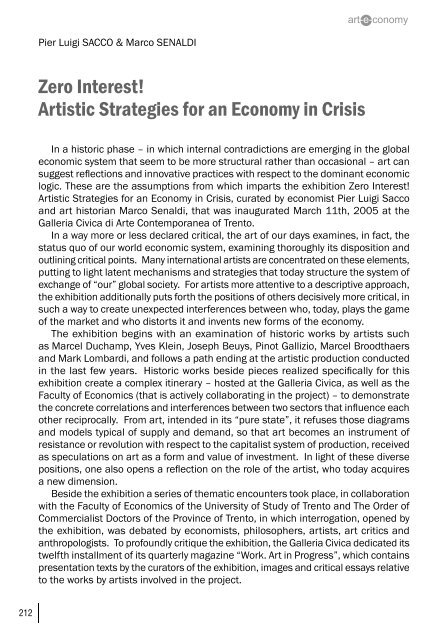art-e-conomy _ reader - marko stamenkovic
art-e-conomy _ reader - marko stamenkovic
art-e-conomy _ reader - marko stamenkovic
Create successful ePaper yourself
Turn your PDF publications into a flip-book with our unique Google optimized e-Paper software.
212<br />
Pier Luigi SACCO & Marco SENALDI<br />
Zero Interest!<br />
Artistic Strategies for an E<strong>conomy</strong> in Crisis<br />
In a historic phase – in which internal contradictions are emerging in the global<br />
economic system that seem to be more structural rather than occasional – <strong>art</strong> can<br />
suggest reflections and innovative practices with respect to the dominant economic<br />
logic. These are the assumptions from which imp<strong>art</strong>s the exhibition Zero Interest!<br />
Artistic Strategies for an E<strong>conomy</strong> in Crisis, curated by economist Pier Luigi Sacco<br />
and <strong>art</strong> historian Marco Senaldi, that was inaugurated March 11th, 2005 at the<br />
Galleria Civica di Arte Contemporanea of Trento.<br />
In a way more or less declared critical, the <strong>art</strong> of our days examines, in fact, the<br />
status quo of our world economic system, examining thoroughly its disposition and<br />
outlining critical points. Many international <strong>art</strong>ists are concentrated on these elements,<br />
putting to light latent mechanisms and strategies that today structure the system of<br />
exchange of “our” global society. For <strong>art</strong>ists more attentive to a descriptive approach,<br />
the exhibition additionally puts forth the positions of others decisively more critical, in<br />
such a way to create unexpected interferences between who, today, plays the game<br />
of the market and who distorts it and invents new forms of the e<strong>conomy</strong>.<br />
The exhibition begins with an examination of historic works by <strong>art</strong>ists such<br />
as Marcel Duchamp, Yves Klein, Joseph Beuys, Pinot Gallizio, Marcel Broodthaers<br />
and Mark Lombardi, and follows a path ending at the <strong>art</strong>istic production conducted<br />
in the last few years. Historic works beside pieces realized specifically for this<br />
exhibition create a complex itinerary – hosted at the Galleria Civica, as well as the<br />
Faculty of Economics (that is actively collaborating in the project) – to demonstrate<br />
the concrete correlations and interferences between two sectors that influence each<br />
other reciprocally. From <strong>art</strong>, intended in its “pure state”, it refuses those diagrams<br />
and models typical of supply and demand, so that <strong>art</strong> becomes an instrument of<br />
resistance or revolution with respect to the capitalist system of production, received<br />
as speculations on <strong>art</strong> as a form and value of investment. In light of these diverse<br />
positions, one also opens a reflection on the role of the <strong>art</strong>ist, who today acquires<br />
a new dimension.<br />
Beside the exhibition a series of thematic encounters took place, in collaboration<br />
with the Faculty of Economics of the University of Study of Trento and The Order of<br />
Commercialist Doctors of the Province of Trento, in which interrogation, opened by<br />
the exhibition, was debated by economists, philosophers, <strong>art</strong>ists, <strong>art</strong> critics and<br />
anthropologists. To profoundly critique the exhibition, the Galleria Civica dedicated its<br />
twelfth installment of its qu<strong>art</strong>erly magazine “Work. Art in Progress”, which contains<br />
presentation texts by the curators of the exhibition, images and critical essays relative<br />
to the works by <strong>art</strong>ists involved in the project.


